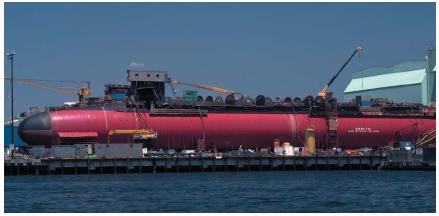Submarine
A submarine is a ship capable of operating underwater. Because its great advantage is its ability to stay hidden, the submarine has developed as a tool of warfare.
In 1578, in his book Inventions or Devices, William Bourne described a ship with two hulls (bodies), one made of wood, the other of leather. According to Bourne, the ship could be submerged or raised by taking in or expelling water from between the double hulls.
The first known submarine to be built was by Dutch inventor Cornelius Drebbel. It consisted of greased leather over a wooden framework. It was propelled either on or beneath the surface by eight oars sealed through the sides with leather flaps. During a demonstration for English king James I in 1620, Drebbel's vessel was successfully piloted just under the surface of the Thames River in London. However, it did not make deep descents.
During the American Revolution (1776–81), American inventor David Bushnell built a one-man submarine called the Turtle. It was 6 feet (2 meters) tall and resembled a slightly squashed egg. It had two hand-cranked screw propellers, a hand-operated control lever connected to the rudder, foot-operated pumps to let water in or send it out (to submerge or surface), and a control panel. The Turtle also had a large explosive attached to it in the hopes the operator could maneuver under an enemy ship, screw the explosive into the ship's hull, and depart before the explosive's timing device discharged it. On its only test mission, the Turtle failed to sink its target.
Robert Fulton
Perhaps the most successful early submarine was designed by American inventor Robert Fulton. He lived in an age of naval battles, but hated war. Fulton hoped that a device that could make warships ineffective would end war altogether. In 1801, he built a 21-foot (6-meter) vessel with a two-bladed propeller, which he called Nautilus. After he was unable to interest both the French and English governments in his idea, Fulton abandoned the submarine project, returned home, and went on to produce his famous steamboats in the United States.
After the American Civil War (1861–65), designers sought alternatives to human-powered propulsion for submarines. Several systems proved unsuitable; for instance, steam engines made the craft unbearably hot and an electric battery could not be recharged at sea.
In the late 1890s, Irish-born American John Holland solved these problems by adding a second power source, the gasoline engine, to the batteries then in use. Because it needed oxygen, the gasoline engine could not be used while a submarine was underwater. When the ship was above water, its engine could provide propulsion and charge the batteries used while the ship had been submerged. Holland's vessels incorporated many of the features found in modern submarines: a powerful engine, advanced control and balancing systems, and a circular-shaped hull to withstand pressure. The United States Navy accepted his submarine, the U.S.S. Holland, in 1900.
Periscopes and diesel engines
Around this time, two other improvements were introduced. Inventor Simon Lake created the first periscope specifically for submarines. A periscope is a vertical telescope that provides a magnified view and a wide angle of vision. In the 1890s, Rudolf Diesel invented an engine that was fired by compression rather than an electric spark. The diesel engine was more economical than the gasoline engine and its fumes were much less toxic (poisonous) and volatile (explosive). This new engine became essential to all submarines until nuclear power was introduced as a means of propulsion in the 1950s.
In World War II (1939–45), submarines played a large role in Germany's repeated attacks on Allied (English, American, and French) ships. Meanwhile, American submarines crippled the Japanese by sinking nearly 1,400 merchant and naval ships. During this time, the snorkel was developed. It was a set of two fixed air pipes that projected from the sub's topside. One tube brought fresh air into the vessel, and the other vented engine exhaust fumes. Now a sub could stay hidden below the surface when running on its diesel engine and recharging its batteries.
Nuclear power
The greatest modern advance in submarine technology was the introduction of nuclear power. With the encouragement of U.S. Navy captain Hyman Rickover, American inventors designed the U.S.S. Nautilus, the first nuclear-powered submarine. Launched in 1955, the U.S.S. Nautilus carried a reactor in which controlled nuclear fission provided the heat that converted water into steam for turbines. With this new power source, the submarine could remain underwater indefinitely and cruise at top speed for any length of time required.
However, the traditional needle-like shape proved inefficient for such a submarine. A new teardrop design was introduced in the United States. Vessels with this improved shape easily drove through the water at speeds of 35 to 40 knots (about 40 to 46 miles or 64 to 74 kilometers) per hour. The U.S. Navy later adopted this shape for its submarines.
[ See also Diesel engine ; Nuclear power ]

Comment about this article, ask questions, or add new information about this topic: